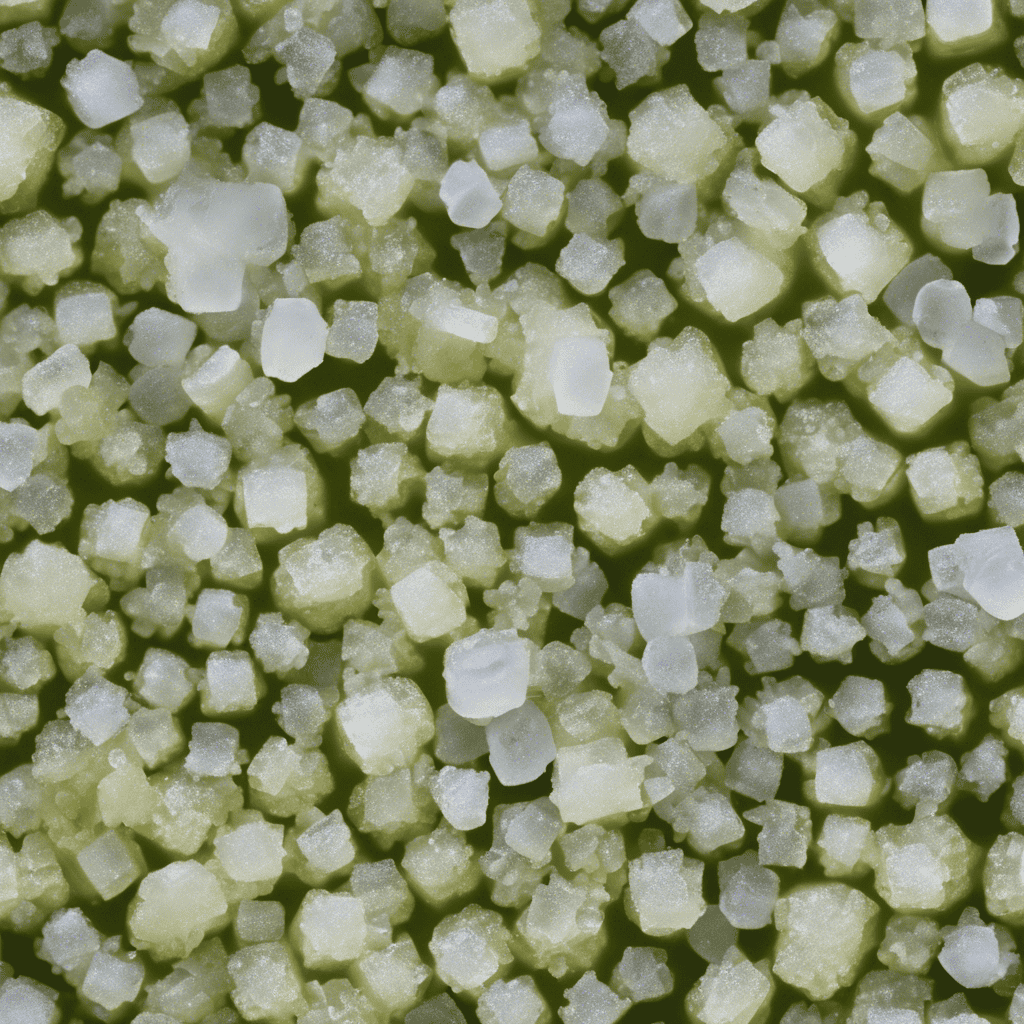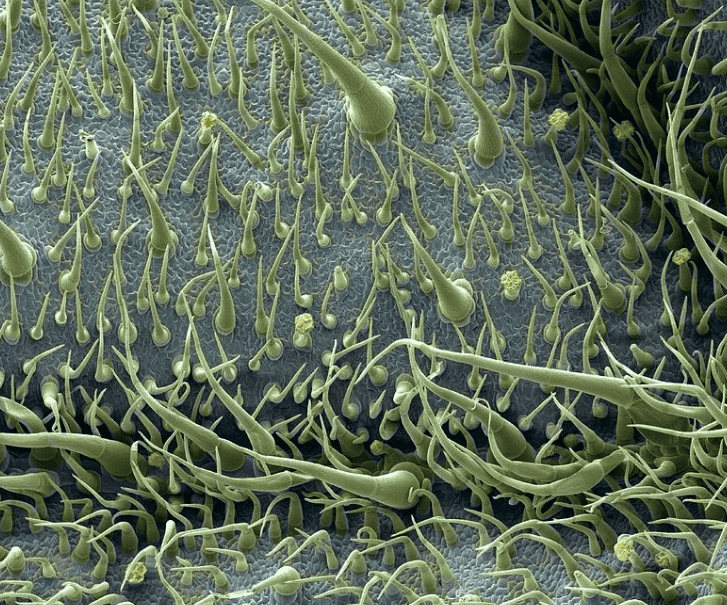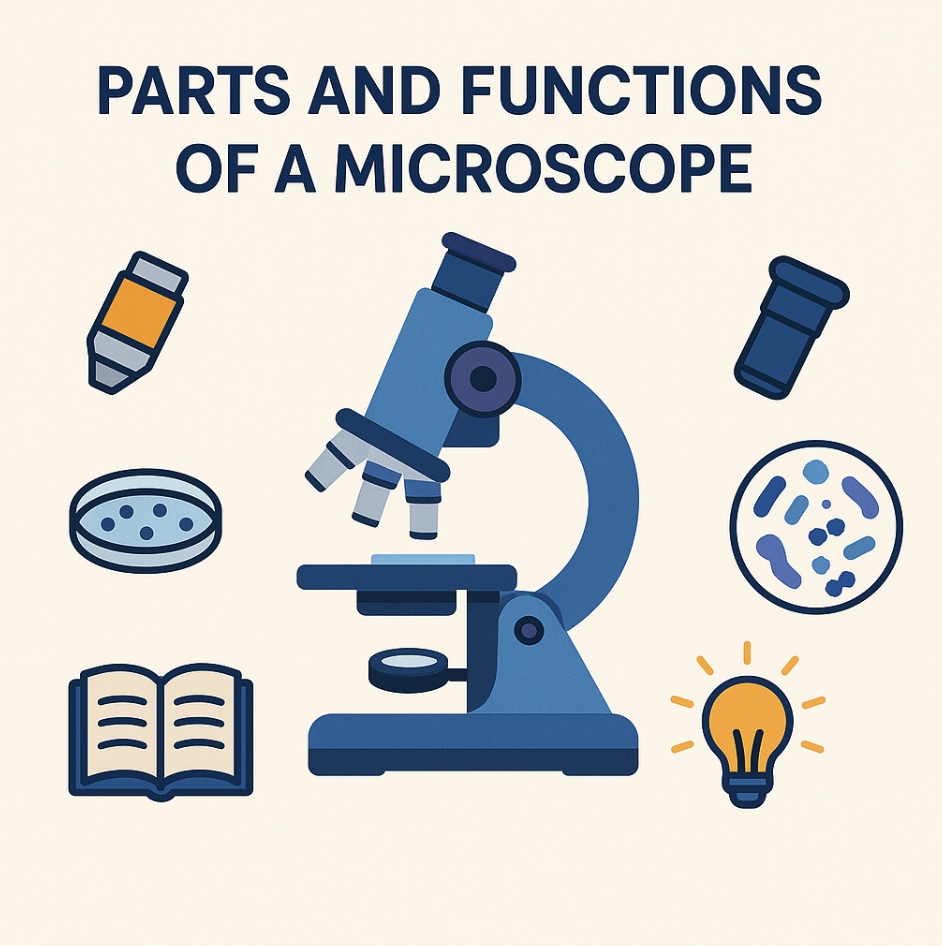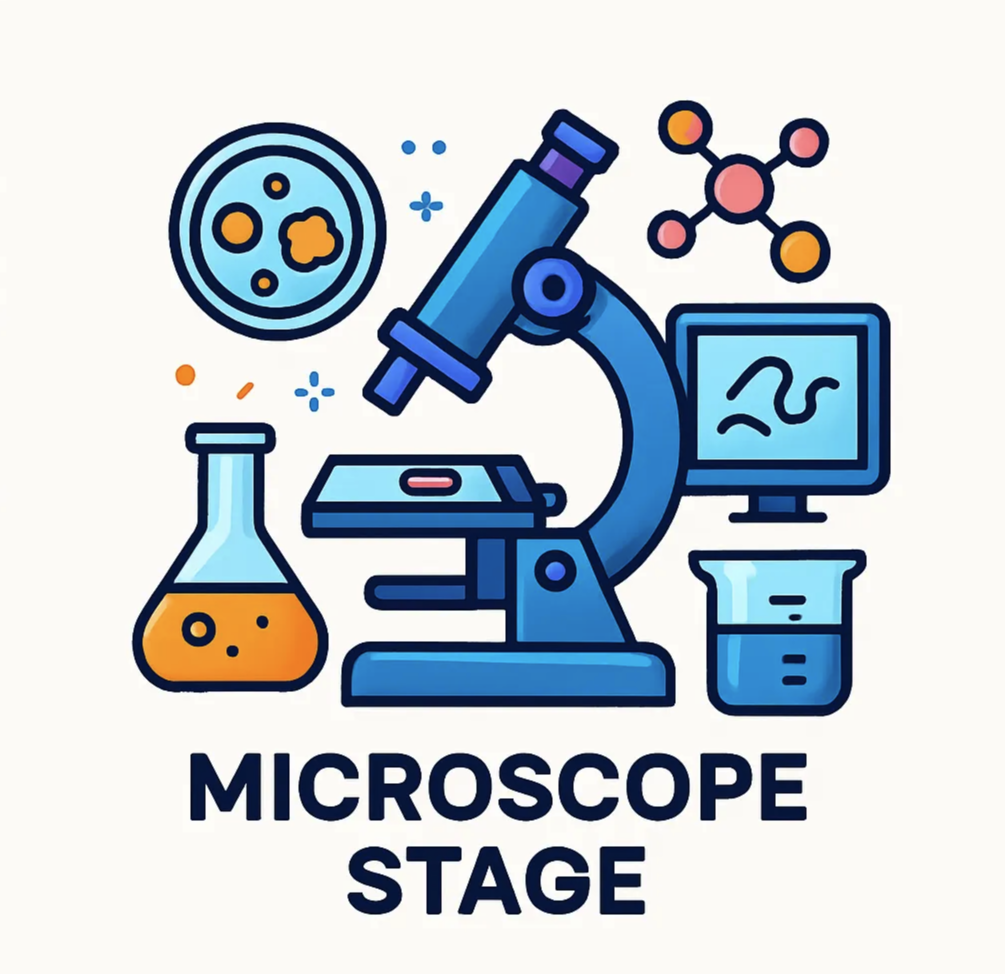
Have you ever wondered what everyday objects would look like if magnified a thousand times? Many are far more intricate and detailed than we realize. In this blog, we’ll journey into the fascinating world of common things under a microscope, revealing secrets invisible to the naked eye.
Ready for an adventure in your own home? Let’s get started!
Key Takeaways
| Microscopes are tools that magnify tiny objects, revealing intricate details not visible to the naked eye. |
| Everyday objects like rose petals, pencil tips, and even dust bunnies have hidden beauty and complexity when viewed under a microscope. |
| Examining these objects at a microscopic level helps us appreciate the wonders of nature, gain new perspectives on familiar things, and understand how they function in our daily lives. |
What is a Microscope?
A microscope is a tool that makes tiny things look big. It uses lenses to show us a hidden world. This tool opens doors into a small but complex place we can’t see with our bare eyes. Things like bugs, leaves, and hair strands become very big when seen through it.
Once you learn how to use the microscopy device, you get to explore the exciting world of tiny wonders! 🧭
Everyday Objects Under a Microscope: A Fascinating World Revealed
Get ready to explore a fascinating world as we examine everyday objects under a microscope. From the delicate scales of a butterfly to the tiny grooves on a vinyl record, there is so much hidden beauty and intricate detail waiting to be discovered.
Rose Petal
A rose petal may seem simple, but when you look at it under a microscope, you’ll be amazed by its intricate details. The delicate petals have tiny ridges and patterns that create a beautiful design. You can see the different layers of cells that make up the petal and observe how they are arranged. It’s like entering a whole new world! Exploring a rose petal under a microscope can help us appreciate the hidden beauty in even the simplest things around us.
We can learn about the structure of plants and how they grow. So next time you see a rose, take a moment to imagine what it would look like up close under a microscope!
Margarita Salt
 Margarita salt is an interesting everyday object to explore under a microscope. When you look at margarita salt up close, you will see tiny crystals that make up the salt. These crystals have different shapes and sizes, which give the salt its unique texture and appearance.
Margarita salt is an interesting everyday object to explore under a microscope. When you look at margarita salt up close, you will see tiny crystals that make up the salt. These crystals have different shapes and sizes, which give the salt its unique texture and appearance.
Additionally, examining margarita salt under a microscope allows us to learn about its composition and how it interacts with liquids like water or lime juice. By exploring margarita salt at a microscopic level, we can appreciate the complexity of this common ingredient in cocktails and gain a new perspective on something we might take for granted.
Butterfly Scales
Have you ever wondered what a butterfly’s scales look like up close? Well, when you examine them under a microscope, they reveal a stunning and intricate pattern. Butterfly scales are tiny structures that cover the wings of butterflies and moths. They come in different shapes, sizes, and colors, creating beautiful designs. These scales serve several functions for butterflies, including providing insulation, aiding in flight, and attracting mates.
It’s fascinating to see how something so small can hold so much beauty and purpose. It is through exploring butterfly scales under a microscope that we can appreciate the hidden wonders of nature and gain a deeper understanding of these delicate creatures.
Pencil Tip
 The pencil tip is an everyday object that may seem simple, but when examined under a microscope, it reveals a fascinating world of intricate details. Through the lens of a microscope, you can see the graphite particles that make up the writing core of the pencil.
The pencil tip is an everyday object that may seem simple, but when examined under a microscope, it reveals a fascinating world of intricate details. Through the lens of a microscope, you can see the graphite particles that make up the writing core of the pencil.
These particles are layered together and create unique patterns and shapes. You might also notice tiny grooves and imperfections on the surface of the tip. Exploring the pencil tip under a microscope gives us a new perspective on this common tool we use every day. It shows us the hidden beauty and complexity that exists in even the simplest objects around us.
Human Hair
Have you ever wondered what your hair looks like up close? Well, when you examine human hair under a microscope, it reveals some fascinating details. Each strand of hair is made up of different layers that give it strength and elasticity.
You can see the outer layer called the cuticle, which looks like overlapping scales. These scales help to protect the inner layers of the hair and give it its texture. When you zoom in even closer, you might be able to see tiny holes where oil or other substances can get trapped. It’s amazing how something as simple as a strand of hair can hold so much intricate structure when viewed through a microscope!
Cashmere
Cashmere is a type of wool that comes from the soft undercoat of cashmere goats. When you look at cashmere fibers under a microscope, you can see their fine and delicate structure. The fibers appear to be long and twisted, creating a crimped pattern. This gives cashmere its luxurious feel, making it warm and cozy to wear. Examining cashmere under a microscope allows us to appreciate the intricacy and beauty of this natural material.
It’s fascinating how something as simple as goat hair can become such a high-quality fabric through the process of collecting, cleaning, spinning, and weaving.
Tomato Leaf
 When you examine a tomato leaf under a microscope, you’ll discover a whole new world of intricate details. The surface of the leaf is covered in tiny structures called trichomes, which look like small hairs.
When you examine a tomato leaf under a microscope, you’ll discover a whole new world of intricate details. The surface of the leaf is covered in tiny structures called trichomes, which look like small hairs.
These trichomes help protect the plant from pests and diseases. When magnified, you can see the different shapes and sizes of these trichomes, as well as any tiny droplets or crystals on their surface. Examining a tomato leaf up close allows us to appreciate the complexity and beauty that exists even in everyday objects like plants.
Ballpoint Pen Tip
Examining the ballpoint pen tip under a microscope can reveal fascinating details about this everyday object. When magnified, you can see the intricate design of the tiny ball that transfers ink onto paper. Also, you might notice small scratches or imperfections on the surface of the metal tip. This close-up view provides a new perspective on something we often take for granted.
Once you start exploring objects like a ballpoint pen tip under a microscope, we can discover hidden beauty and gain a deeper appreciation for the complexity of even the simplest things in our daily lives.
Pickled Cucumber
When you look at a pickled cucumber under a microscope, you’ll be amazed by what you see! The surface of the cucumber is covered in tiny bumps and ridges, which are actually the cells that make up the cucumber. These cells have unique shapes and structures that help to give the cucumber its crunchy texture. You might also notice small water droplets on the surface of the cucumber, which are part of the pickling process.
Pickles are made by soaking cucumbers in a mixture of vinegar, salt, and spices, which helps to preserve them and gives them their tangy flavor. So next time you enjoy a pickle with your sandwich or burger, take a moment to appreciate all the intricate details that can be seen under a microscope!
Dust Bunny
Did you know that even a simple dust bunny can reveal fascinating details when examined under a microscope? When magnified, you can see that it’s not just a ball of fluff. Dust bunnies are made up of tiny particles like dead skin cells, hair, and fibers from different materials. They may also contain pollen grains and even microscopic organisms.
Looking at a dust bunny under a microscope gives us a new perspective on something we often overlook. It reminds us that there is an intricate world hiding in the most ordinary things around us.
Torn Paper
Torn paper may seem like a simple and insignificant thing, but when you look at it under a microscope, you’ll be amazed by what you see. The edges of the torn paper reveal intricate fibers and textures that are not visible to the naked eye. You can see the individual strands of paper and how they intertwine with each other. It’s fascinating to see the different layers of the torn paper and how they come together to create its unique texture.
Examining torn paper under a microscope can give us a new appreciation for something we often take for granted in our everyday lives.
Brown Sugar
Brown sugar is a common ingredient found in many kitchens. When you look at brown sugar under a microscope, you can see its granulated structure up close. Additionally, the microscope reveals that brown sugar is made up of tiny crystals. These crystals give brown sugar its sweet taste and texture. You may also notice some darker specks in the brown sugar, which are molasses particles. These particles add flavor and color to the sugar.
Examining brown sugar under a microscope gives us a new perspective on this everyday ingredient and shows us the hidden details that make it unique.
Watch Part
 A watch is a small and intricate device that we use to tell the time. But have you ever wondered what it looks like up close? When you put a watch part under a microscope, you’ll be amazed by the tiny gears, springs, and other components that make it tick.
A watch is a small and intricate device that we use to tell the time. But have you ever wondered what it looks like up close? When you put a watch part under a microscope, you’ll be amazed by the tiny gears, springs, and other components that make it tick.
Each part has its own unique shape and purpose, working together to keep your watch running smoothly. By examining a watch part under a microscope, you can unlock the hidden world of this everyday object and appreciate the incredible craftsmanship that goes into making it. It’s like discovering a whole new universe right in front of your eyes!
So next time you see a watch, take a closer look with a microscope and be astounded by the fascinating details that are usually invisible to our naked eye.
Toothbrush Bristles
Toothbrush bristles are tiny, but have you ever wondered what they look like up close? When examined under a microscope, toothbrush bristles reveal an interesting texture and structure. You can see that the bristles are made up of individual strands that come together to form a brush head. These strands may have different shapes or textures depending on the type of toothbrush.
Some toothbrushes have straight bristles, while others have wavy or angled ones. By looking at toothbrush bristles under a microscope, you can appreciate the detail and design that goes into creating these essential oral hygiene tools.
Needle and Thread
One fascinating object to examine under a microscope is a needle and thread. When you zoom in, you can see the tiny loops of the thread wrapped around the sharp point of the needle. It’s amazing to think about how this everyday tool works to hold fabric together. The microscopic details reveal the precision and intricacy involved in sewing. By exploring objects like needles and thread under a microscope, we can gain a deeper appreciation for their functionality and importance in our lives.
Dental Floss
Dental floss is a thin string that you use to clean between your teeth. It might not seem very exciting, but when you look at dental floss under a microscope, it reveals some interesting details. You can see how the fibers are woven together to create a strong and flexible thread. Examining dental floss up close can help us understand why it’s important to floss regularly. By removing plaque and food particles from between our teeth, we can keep our gums healthy and prevent tooth decay.
So next time you’re using dental floss, take a closer look and appreciate its hidden intricacies!
Computer Chip
A computer chip is a small yet crucial component of electronic devices, including computers, phones, and tablets. It looks like a tiny square with lots of little pathways on it. These pathways help the chip to send information and do calculations really fast. When you look at a computer chip under a microscope, you can see all those tiny pathways close up. It’s amazing how something so small can be so powerful!
Exploring a computer chip under a microscope can help us understand how technology works and appreciate the incredible complexity of our electronic devices.
Jewelry Chain
A jewelry chain may seem like a simple accessory, but when you look at it under a microscope, you’ll discover its hidden intricacies. The tiny links that make up the chain are crafted with precision, each one interlocking with the next to create a beautiful and durable piece of jewelry. Examining a jewelry chain under a microscope allows us to appreciate the craftsmanship and attention to detail that goes into making these delicate accessories. We can see the smooth surface of each link, as well as any patterns or designs etched onto them.
It’s truly amazing how something so small can hold so much beauty and complexity.
Grooves on a Vinyl Record
Looking at the grooves on a vinyl record under a microscope can reveal fascinating details. The microscopic examination of these grooves allows us to see the intricate patterns that create the music we love. Each groove is like a tiny road map for the needle, guiding it along and producing sound. By magnifying these grooves, we can appreciate the precision and complexity involved in recording music on vinyl.
It’s amazing to see how something as simple as a groove can hold so much information and bring our favorite songs to life.
Fish Scale
Fish scales are another fascinating object to explore under a microscope. These tiny, overlapping plates cover the bodies of fish and come in various shapes and patterns. Looking at fish scales up close reveals their intricate details and unique textures. The scale’s surface might appear smooth or have ridges, lines, or even small bumps. Examining these scales can help us understand more about the biology of fish and how they adapt to different environments.
It’s truly amazing to see the hidden beauty that exists within something as ordinary as a fish scale when viewed through a microscope!
Carrot
Have you ever wondered what a carrot looks like under a microscope? Well, get ready to be amazed! When you examine a carrot up close, you’ll see its intricate structure. The orange part of the carrot is made up of tiny cells packed with nutrients. And did you know that carrots are actually roots? They have long, thin strands called root hairs that help them absorb water and nutrients from the soil. Looking at a carrot under a microscope can give us a whole new appreciation for this common vegetable and how it grows.
Now, let’s dive deeper into the fascinating world of everyday objects under a microscope. Remember, even the simplest things can hold hidden wonders when seen through magnification!
Strange and Beautiful Things Under a Microscope
Discover the mesmerizing world of everyday objects magnified under a microscope, from the intricate patterns on a coffee bean to the delicate structure of a spider’s head. Prepare to be amazed and intrigued as you delve into this microscopic realm – click here to explore more!
Coffee Bean
Coffee beans are a fascinating object to examine under a microscope. When you take a closer look, you can see the intricate details of the coffee bean’s structure. Additionally, you might be surprised by what you discover. For example, did you know that a coffee bean is actually the seed of a fruit? It starts off as a cherry-like fruit and goes through various processes before becoming the familiar coffee bean we know.
Examining a coffee bean under a microscope allows us to appreciate its unique composition and understand how it transforms from fruit to drinkable beverage. So next time you’re enjoying your morning cup of joe, take a moment to think about all the hidden wonders inside that little coffee bean!
White Sugar
White sugar, when viewed under a microscope, transforms into a fascinating world of intricate crystals. The granules that we sprinkle on our cereal or use in baking are actually composed of tiny crystal structures.
These crystals reflect light and create beautiful patterns. Examining white sugar under a microscope reveals the hidden complexity and beauty of this common household item. By exploring the microscopic realm of white sugar, we can gain a deeper understanding and appreciation for the objects that surround us every day.
Beard Hair
Beard hair is another interesting everyday object to examine under a microscope. When you take a closer look at beard hair, you can see its unique structure and details. Each strand of beard hair has different colors and patterns, which can be fascinating to explore. Examining beard hair under a microscope allows you to see the texture and thickness of the individual hairs. It’s amazing how something as simple as a strand of hair can hold so much complexity and beauty!
So, next time you come across some beard hair, take a moment to observe it under a microscope and discover its hidden wonders!
Staple Poking Through Paper
Have you ever noticed a staple poking through a piece of paper? It may seem like a small and ordinary thing, but when you look at it under a microscope, it becomes fascinating. The sharp metal points of the staple become more visible, and you can see how they stick out from the paper fibers.
It’s interesting to see how something as simple as a staple can have such an impact on the paper it goes through. Exploring objects like this under a microscope helps us appreciate their hidden details and understand the complexity of everyday items around us.
Ballpoint Pen
Under a microscope, a ballpoint pen reveals fascinating details about its structure and design. You can see the tiny ball at the tip that dispenses ink as you write. The ink itself consists of pigments suspended in a liquid solution. Looking closer, you might notice microscopic scratches on the barrel of the pen or imperfections in the plastic casing.
It’s amazing to see how something we use every day can have such intricate features when examined up close!
Wood
Wood is a material that we see and use every day, but have you ever wondered what it looks like under a microscope? When you examine wood at a microscopic level, you can see its intricate structure and patterns.
You might be surprised to discover the tiny channels within the wood called vessels that transport water and nutrients throughout the tree. Examining wood under a microscope can help us understand how trees grow and how different types of wood are used in construction and woodworking. It’s fascinating to see the hidden world within something as ordinary as a piece of wood!
Table Salt
Table salt may seem like a simple and ordinary ingredient, but when you look at it under a microscope, you’ll be amazed at what you see! The tiny crystals of table salt reveal a world filled with intricate patterns and shapes.
Each crystal is made up of sodium and chloride ions that arrange themselves into repeating geometric structures. When magnified, these structures create stunning images that resemble delicate snowflakes or sparkling diamonds. Exploring table salt under a microscope can help us understand the hidden beauty and complexity of even the most everyday objects around us.
When you next sprinkle some salt on your food, take a moment to appreciate its microscopic wonders!
Razor Blade
A razor blade is a small tool used for shaving or cutting hair. When you look at a razor blade under a microscope, you can see its sharp edges and the tiny ridges on the blade. It may seem simple, but there is actually a lot of precision involved in making a razor blade.
The microscopic examination reveals the fine craftsmanship and attention to detail that goes into creating this everyday object. It’s fascinating to see how something so small can be so important in our daily lives.
Penny
A penny may seem like a simple coin, but when you look at it under a microscope, you’ll be amazed by what you see. The close-up view reveals the tiny details that make up this everyday object.
You can see the texture and lines on the surface of the penny, as well as any scratches or imperfections. It’s fascinating to think about how many pennies we handle every day without noticing these hidden features. Looking at a penny under a microscope helps us appreciate the intricate design and craftsmanship that goes into making such a small piece of currency.
Whenever you have a penny in your hand, take a closer look and discover its microscopic wonders!
Spider Head
Under a microscope, the head of a spider can be quite fascinating to examine. You’ll be able to see its tiny eyes, which are usually arranged in two rows. Spiders have many eyes, and looking at them up close can reveal their intricate structure.
The hairs on the spider’s head will also become more visible – they help the spider sense its environment by picking up vibrations in the air. Examining a spider’s head under a microscope gives us an opportunity to appreciate the incredible details and adaptations that exist in even the smallest creatures. It’s amazing what we can discover when we take a closer look!
Explore the incredible world of everyday objects under a microscope and unlock their hidden wonders. By examining things like rose petals, butterfly scales, and pencil tips, we can discover the intricate details and beauty that are often invisible to the naked eye. Through this exploration, we gain a deeper understanding of the complexity of our world and learn to appreciate the extraordinary in the ordinary.
So grab a microscope and embark on an exciting journey into the fascinating realm of microscopic objects!
FAQs
1. What does it mean to explore everyday objects under a microscope?
Exploring everyday objects under a microscope means we look at common items very closely. We use a tool called a microscope to see hidden details.
2. Why should we examine ordinary objects under a microscope?
Examining ordinary objects with a microscope lets us see the intricate beauty and fascinating realm of these items up close.
3. What can be learned by looking at things through microscopy?
When you delve into the microscopic world, you learn about the complex nature of common items that stay unnoticed in daily life.
4. How are transformations seen when viewing objects under magnification?
Under magnification, regular surfaces show amazing changes which reveal microscopic wonders that our eyes can’t ordinarily see.
5. Can one uncover secrets of an item using microscopic analysis?
Yes! The hidden intricacies and complexity within normal things come alive when exploring them under microscopes enabling us to understand their unseen beauty.


